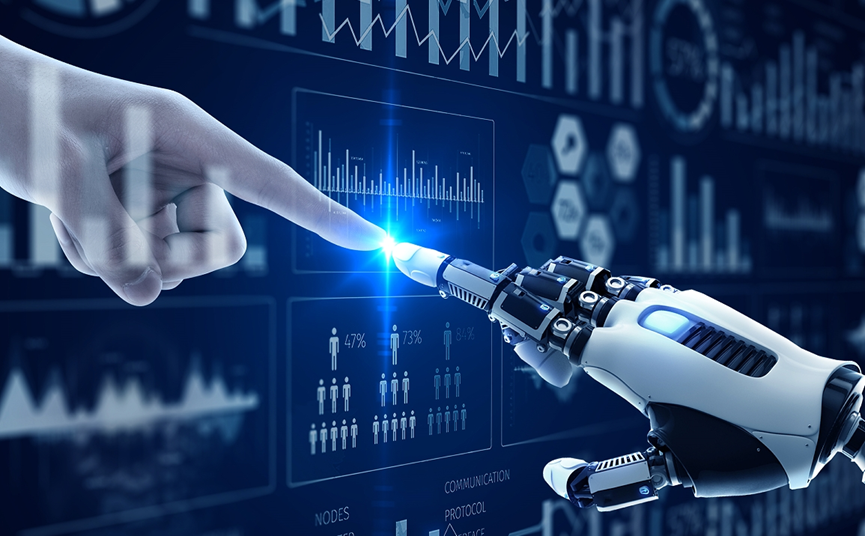Robotics and automation technologies have a wide range of application fields. From industrial production workshops to medical operating tables, from logistics and distribution warehouses to home service scenarios, their presence can be seen, profoundly changing the way of production and life.

Image Source:699pic
I. Continuous Expansion of the Industrial Scale and Continuous Expansion of Application Areas
In recent years, the market scale of robotics and automation in China has been growing steadily. Take industrial robots as an example. Riding on the momentum of the transformation and upgrading of the manufacturing industry, China has been the world's largest application market for industrial robots for consecutive years. In industries such as automobiles, electronics, and metal processing, the characteristics of industrial robots, such as high efficiency, precision, and stability, have greatly improved production efficiency and reduced labor costs. Automobile manufacturing enterprises have introduced a large number of industrial robots to complete tasks such as welding and assembly. Not only has the production cycle been shortened, but the product quality is also more guaranteed.
At the same time, the service robot market is developing rapidly. Household cleaning robots, educational and companion robots, medical nursing assistance robots, etc. are gradually entering the public's life. With the arrival of an aging society, the demand for medical and nursing services has increased significantly. Nursing assistance robots can assist medical staff in completing simple nursing tasks, relieve the pressure on human resources, and provide life assistance for the elderly.
II. Frequent Technological Innovation Achievements, but Core Technologies Still Need to Be Broken Through
China has achieved fruitful results in technological innovation in robotics and automation. Significant progress has been made in technical fields such as robot motion control algorithms and machine vision recognition, and some technologies have reached the international advanced level. In complex industrial environments, relying on advanced motion control algorithms, robots can accurately complete complex actions, improving production accuracy and efficiency. The progress of machine vision recognition technology enables robots to identify and grasp target objects more quickly and accurately, playing an important role in scenarios such as logistics sorting and industrial inspection.
Some high-end reducers in China rely on imports, which limits the development of the industry. China is increasing its R&D investment, and many scientific research institutions and enterprises are actively involved in the research and development of core technologies. Some enterprises have made breakthroughs in the localization of servo motors, and the product performance is gradually improving, which is expected to gradually achieve import substitution.
III. Increased Policy Support and Gradual Improvement of the Industrial Ecosystem
The state attaches great importance to the development of the robotics and automation industry and has introduced a series of policies to support it. Policy documents such as the "14th Five-Year Plan for the Development of the Robotics Industry" have clarified the goals and directions for the industry's development, and provided policy support and financial support in aspects such as R&D investment, technological innovation, application promotion, and talent cultivation, stimulating the innovation vitality of enterprises and promoting the rapid development of the industry.
Local governments have also introduced supporting policies one after another, building robotics industry parks and innovation bases, attracting the gathering of enterprises, universities, and scientific research institutions, and promoting in-depth integration of production, education, and research. Regions such as the Yangtze River Delta, the Pearl River Delta, and the Beijing-Tianjin-Hebei region have formed industrial clusters, and the industrial ecosystem has been gradually improved. Enterprises upstream and downstream of the industrial chain develop in coordination. From the manufacturing of core components, the production of robot complete machines to system integration applications, all links are closely coordinated, enhancing the overall competitiveness of the industry.
IV. Challenges and Opportunities Coexist, and the Future Development Still Has a Long Way to Go
Although China's robotics and automation industry has achieved remarkable results, it also faces many challenges. In addition to the bottleneck of core technologies, the market competition is fierce, and the products of some enterprises are seriously homogeneous. Price wars affect the healthy development of the industry. The application cost of robots is relatively high, especially in small and medium-sized enterprises, there are obstacles to popularization. There is a shortage of relevant professional talents, which restricts the innovative development of the industry.
However, challenges and opportunities coexist. With the deep integration of emerging technologies such as 5G, artificial intelligence, and big data with robotics and automation technologies, new development opportunities will be brought to the industry. The characteristics of low latency and high bandwidth of 5G technology can realize the remote real-time control of robots and expand application scenarios. The development of large artificial intelligence models will improve the intelligence level of robots, enabling them to have stronger learning, decision-making, and adaptation abilities.
Under the new development pattern, China's huge domestic demand market, complete industrial system, and continuous innovation investment will provide broad space for the development of the robotics and automation industry.
- pre:The Development Trajectory and Diverse Applications of Packaging Machines Since Entering China
- next:AI empowers medical equipments
Please click to consult us immediately or call the hotline: 4006-979-616We will solve the problems in your heart in detail。Online consultation



 Online Service
Online Service
